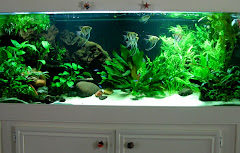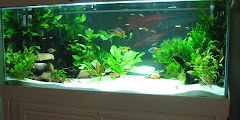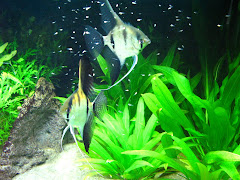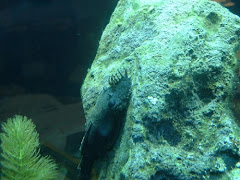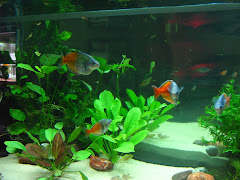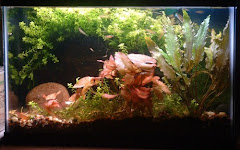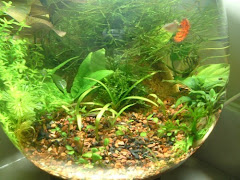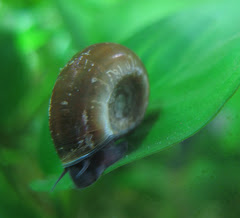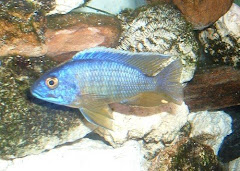Back again, and the Altolamps have established residence. It will be another month or so before I will have any frontosa, so last month I decided to take advantage of some very good prices at the LFS on some A. compressiceps and a trio of what are alleged to be A. calvus "inkfin." I am not sure about the compressiceps, though they ought to be gold heads, but at the small size it is very difficult to tell what you have when it comes to comps. I got three that I thought were small at 2", but then I got another pair of comps that are much smaller, and wonder if it was such a good idea. The three larger ones are out in the open, waiting for food, but the smaller ones hide and are chased into rock piles. I have one very nice calvus that stays out with the comps, so it would appear that I have 3 2" comps and one 1" calvus, though there are two more calvus in the rocks and two more comps in the rocks as well.
I simply adore these fish. They have to be, without question, my favorite genus of aquarium fish. I used to be partial to calvus, but the comps have their place in my heart as well. There is something bulldog-ish and pugnacious about their jaw and head shape that I think is great, and I could watch them endlessly.
My rationale was that if I had to wait so many months for the frontosa, which are almost guaranteed to be about 1.5-2" in size themselves when I get them, then that would give me time to grow out some Altolamps if I found some at a good price, which I did. Finding 3"+ adults is harder, and the price is high for them, typically, due to what has been a lot of food and care put into getting them to that size. I probably don't need to point out that this genus is veeeerrrry slow growing. Very. Startlingly. A fish a year old looks like fry of other types of fish. Therefore, I risk losing these fish if the frontosa grow up quickly and decide to make lunch out of the altolamps. I hope the rockwork I have in place is adequate.
Now, if you notice from prior posts, I have not mentioned the goldfish. I had three rather sizable fantail fellows, great chaps, full of energy and good humor, quite attractive, in fact, and three of the same sort but smaller versions. I had to remove the three larger ones, because they seemed quite interested in the comps and calvus, and I was worried they'd try to eat them. The goofy goldfish do not take the cues of these pint-sized cichlids (okay, fingernail sized....) and I felt they were being stressed. Plus, goldfish have completely wrong energy for this tank, but I kept them in place to feed bacteria until I got my fronts. I sold them back to the store, reluctantly, because I found them so attractive, but had nowhere for them to go. :(
Now I have the three small goldfish still in residence, but they do not belong there, sadly. I don't know if they are contributing the wrong thing to the tank, with their filthy goldfish-ness. I don't wish to detract from their appeal, because they are very nice specimens and have beautiful finnage and lively behavior, but they JUST DON'T GO with Altolamprologus. I am sure I'd be hauled away in chains if any cichlid snob happened by the house - you just don't do this kind of thing! However, for the time being I'm keeping them together, as incongruous as it appears. I don't think these three goldies provide the same bioload as 10 1-2" frontosa fry, but it sure helps.
I have tried to get some pictures of the new additions, but they dart into the rocks when I bring out the camera. I need to get them used to it. Another issue is that the tank is very dim, by design. Well, it is not so dim as to not be viewable, but it is dim for taking pictures. The ideal frontosa tank, to me, is dimmer than your average aquarium. What I will need to do is mount some sort of lamp inside on the glass divider to put extra light when I want to take photos. This will spook the fish, though....
As for lighting, there have been changes, and I've got mixed feelings. I had amazingly simple puck lighting in the hood, which consisted of a round "puck" comprised of 50-60 LED bulbs, connected with a detachable 12" cord, which was in turn connected to another puck, etc. I had about 6 of them dotted around the inside of the hood. They provided almost a spot-lit effect, pretty dim, but nifty looking. You could unscrew and remove any individual puck without putting out the rest of the string.
Well, it was designed for under-cabinet use in the kitchen, and I suppose the humidity of an aquarium hood was too much. One by one each puck started going out. There was no scorched cord, no short that I could see, nothing visibly amiss, but obviously this was not going to work. I decided to rethink the prospect. I once again went online and began shopping for LED fixtures meant for the aquarium. Sticker shock! Really? Must I pay such prices for a light fixture? I suppose at some point they will become more popular and the price will go down, but honestly, I can't justify it. I'd sooner take one of my old fluoro fixtures and stick it up there.
Fortunately, or not, the Christmas Season is upon us, being a couple of days past Halloween at the time I was looking into things. The other fortunate thing, or not, is that LED Christmas lights are wildly popular now, and you are almost criminal for buying the regular old-fashioned kind these days. LED = Green, and, like Kermit says, it is not easy being green. Expensive, really. However, a string or two of LED lights, simple round balls, was not too much for me compared to the cost of a full LED aquarium fixture. For stringing around my tree and possibly (or not) throwing out with the tree, it is highway robbery. I digress.....
I spotted, at a very reasonable price, a ROPE LIGHT that had white LED bulbs inside. I have a rope light already, purchased several years ago with the intent of lively holiday decoration, but never used it. I plugged it in and it looks downright yellow for the aquarium application. The box of Christmas lights, all kinds of them, specify whether they are "warm white" or "bright white," so I chose bright, and installed the rope inside my hood. It came with the clips that hold the rope, so I had everything I needed. The light is perfect, though a bit on the dim side. How about two? Okay, better, but still...... I wound up with one of those net lights that you plop upon your unsuspecting azalea or boxwood, making your neighbors think (lol) that you individually strung your bushes with lights. I stapled one of those (LED, bright white) up inside the hood, and now we are, as they say, cooking with gas.
These lights, rope and net, all promise indoor as well as outdoor applications, meaning they ought to be able to handle some humidity, nay, pounds of snow and subsequent melt, or rainstorms, so they ought to work inside my hood, right? Let's hope. I am certain that they will last a few months, at least until the Christmas aisles are all vanished from the stores and the rain boots and fertilizer is on sale at Target, and then they'll give out. We shall see. I am determined not to pay several hundred dollars for an LED fixture for this aquarium, however.
Saturday, November 20, 2010
Subscribe to:
Posts (Atom)

